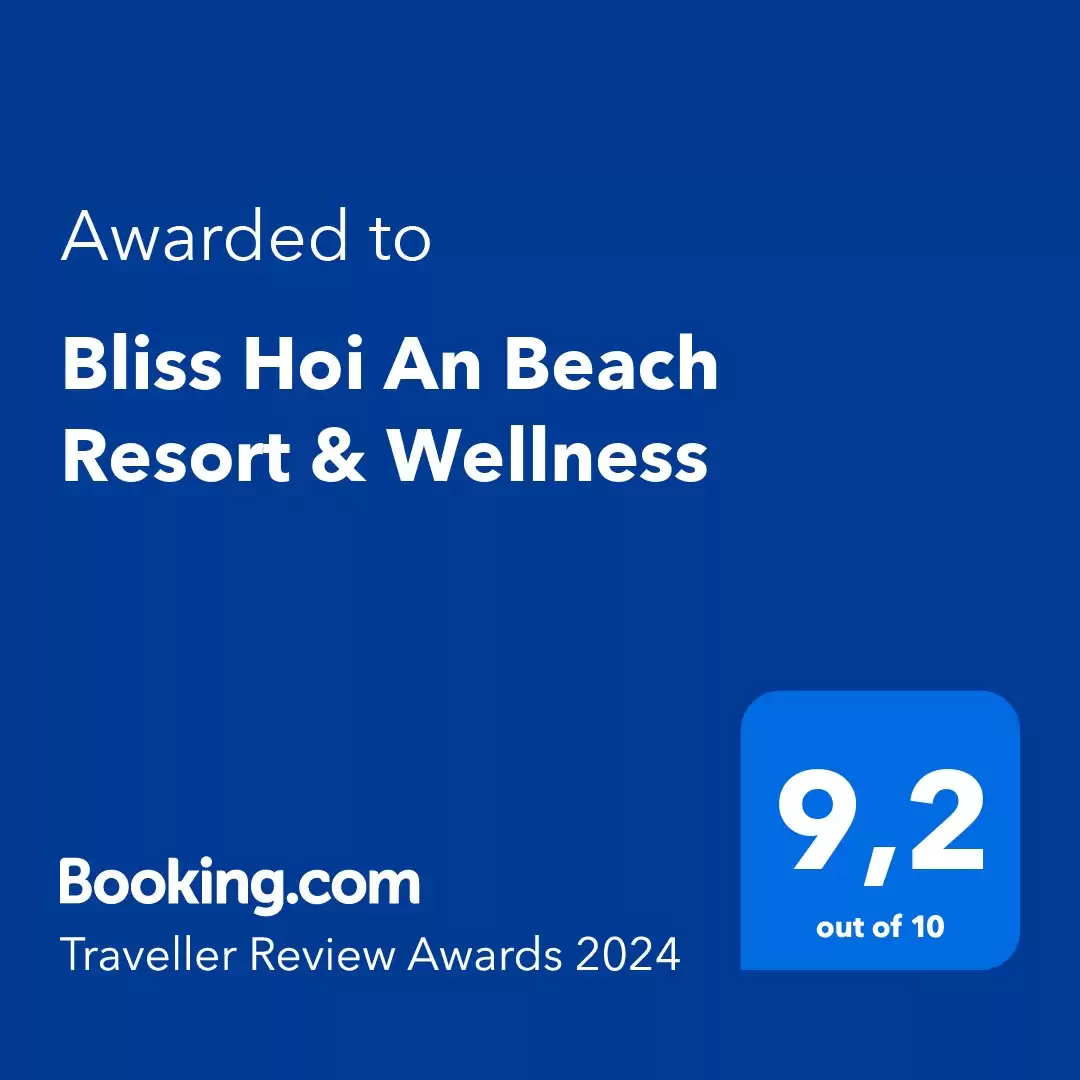Best time to visit Danang Hoi An and Hue for the perfect Central Vietnam trip
Planning a trip to Central Vietnam can be even more rewarding when you know the best time to visit Danang Hoi An and Hue. Each city has its own rhythm, shaped by the seasons, cultural events, and local traditions. From sun-filled beaches to atmospheric lantern festivals and imperial heritage sites, timing your visit right allows you to experience the best of what these destinations have to offer.
Da Nang – The coastal gem of Central Vietnam
Located in the heart of Central Vietnam along the East Sea, Da Nang is just about 30 km from Hoi An and 100 km from Hue. The city stands out for its perfect blend of natural beauty and modern architecture.
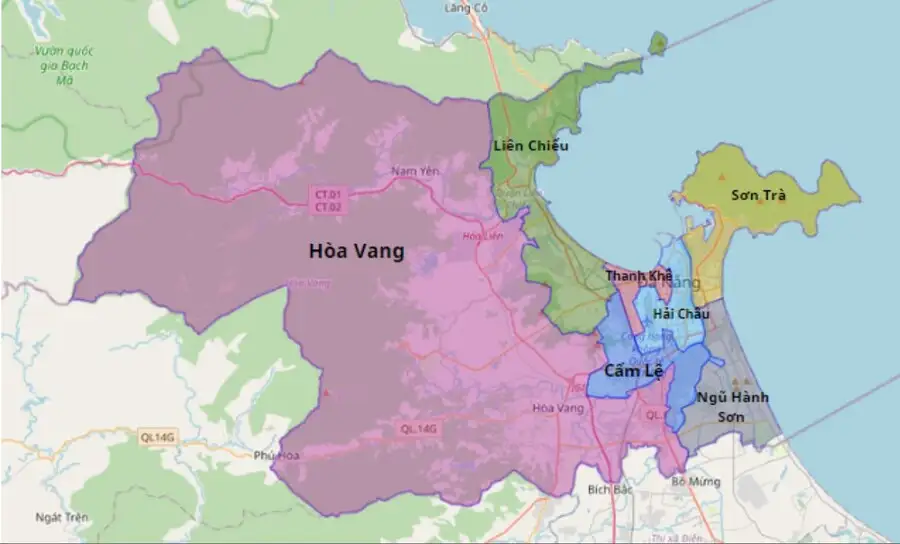
Da Nang is famous for its long, scenic beaches such as My Khe, Non Nuoc, and Bac My An, where visitors can relax, sunbathe, or enjoy water sports. Other notable attractions include Ba Na Hills, the Marble Mountains (Ngu Hanh Son) and the Son Tra Peninsula.
Beyond its natural landscapes, Da Nang impresses with modern landmarks like the Dragon Bridge, Tran Thi Ly Bridge, and the sparkling Han River at night. Visitors should not miss the city’s signature Central Vietnamese cuisine, including Mi Quang, Banh Xeo, and fresh seafood. In the evening, strolling along the Han River or taking photos at the Dragon Bridge when it breathes fire and water offers unforgettable experiences.
Therefore, travelers planning their trips often pay close attention to the weather, temperature, and climate conditions to choose the best time to visit Danang Hoi An and Hue and fully enjoy the beaches, ancient town, and historical sites.
Read more: Where is Danang? Discover Vietnam’s central coastal city
Weather
Da Nang has a typical tropical monsoon climate with two distinct seasons, each offering different experiences for travelers.
- Dry season (February-July):
During this period, the weather is mostly sunny with little rain, and temperatures range from 28-33°C. The air is fresh and clear, ideal for outdoor activities such as beach outings, kayaking, trekking at Ba Na Hills, or exploring the Marble Mountains (Ngu Hanh Son). The dry season is also perfect for visiting outdoor attractions and taking photos at modern landmarks like the Dragon Bridge or along the sparkling Han River in the evening.
- Rainy season (August-December):
This season brings heavy rain, occasional storms, and floods, with temperatures ranging from 25-30°C. Travelers should be cautious while moving around, as roads may be slippery and some outdoor attractions might limit access. However, this period also sees fewer tourists, and many resorts and restaurants offer special deals, making it a great time for relaxation, enjoying local cuisine, and spa experiences.
Climate highlights by month:
- March – May: sunny, mild, and comfortable – perfect for all outdoor activities and sightseeing.
- June-July: hotter, but the beaches remain beautiful; ideal for water sports, swimming, strolling along the river, or visiting resorts.
- September-November: heavy rain and occasional storms, not suitable for outdoor activities; travelers are advised to consider indoor attractions, culinary experiences, or spa visits as alternatives.
Best time to visit
The ideal time to explore Da Nang is from March to May, when the weather is pleasant, sunny, and perfect for visiting all the city’s highlights. Travelers can fully enjoy everything from pristine beaches and majestic mountains to famous attractions such as Ba Na Hills and the Marble Mountains (Ngu Hanh Son).
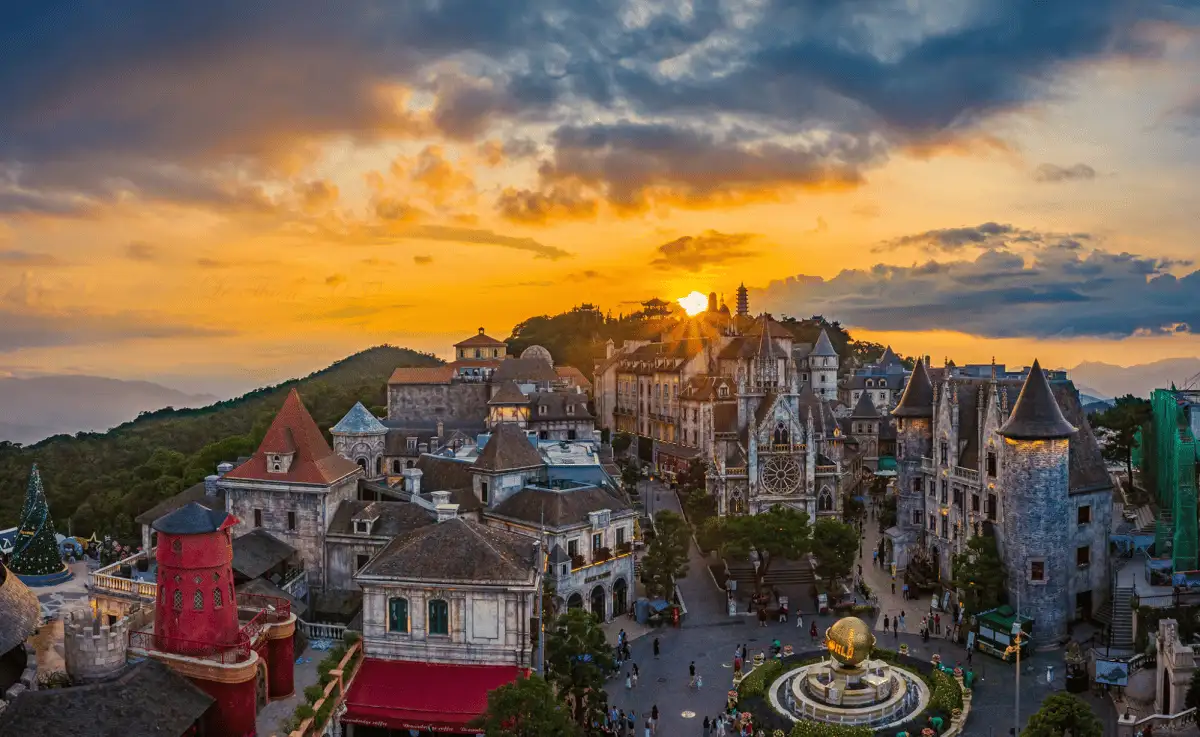
June to July is also suitable, especially for those who enjoy beach activities. However, the sun can be quite strong, so visitors should prepare with sun protection, hats, sunscreen, and plenty of water for outdoor activities.
Hoi An – The timeless ancient town by the Hoai River
Located about 30 km south of Da Nang, Hoi An is a UNESCO World Heritage site, renowned for its serene yet vibrant charm and well-preserved ancient architecture. The town offers rich cultural experiences through its vibrant lantern festivals, boat rides on the Hoai River at sunset, and cooking classes that provide deeper insights into the culinary heritage of Central Vietnam.
The old town captivates visitors with streets adorned by colorful lanterns and traditional buildings, including historic houses, pagodas, and unique assembly halls. Surrounding Hoi An are traditional craft villages, such as Thanh Ha pottery, lantern making, and woodcraft, where travelers can watch artisans at work and purchase finely crafted souvenirs.
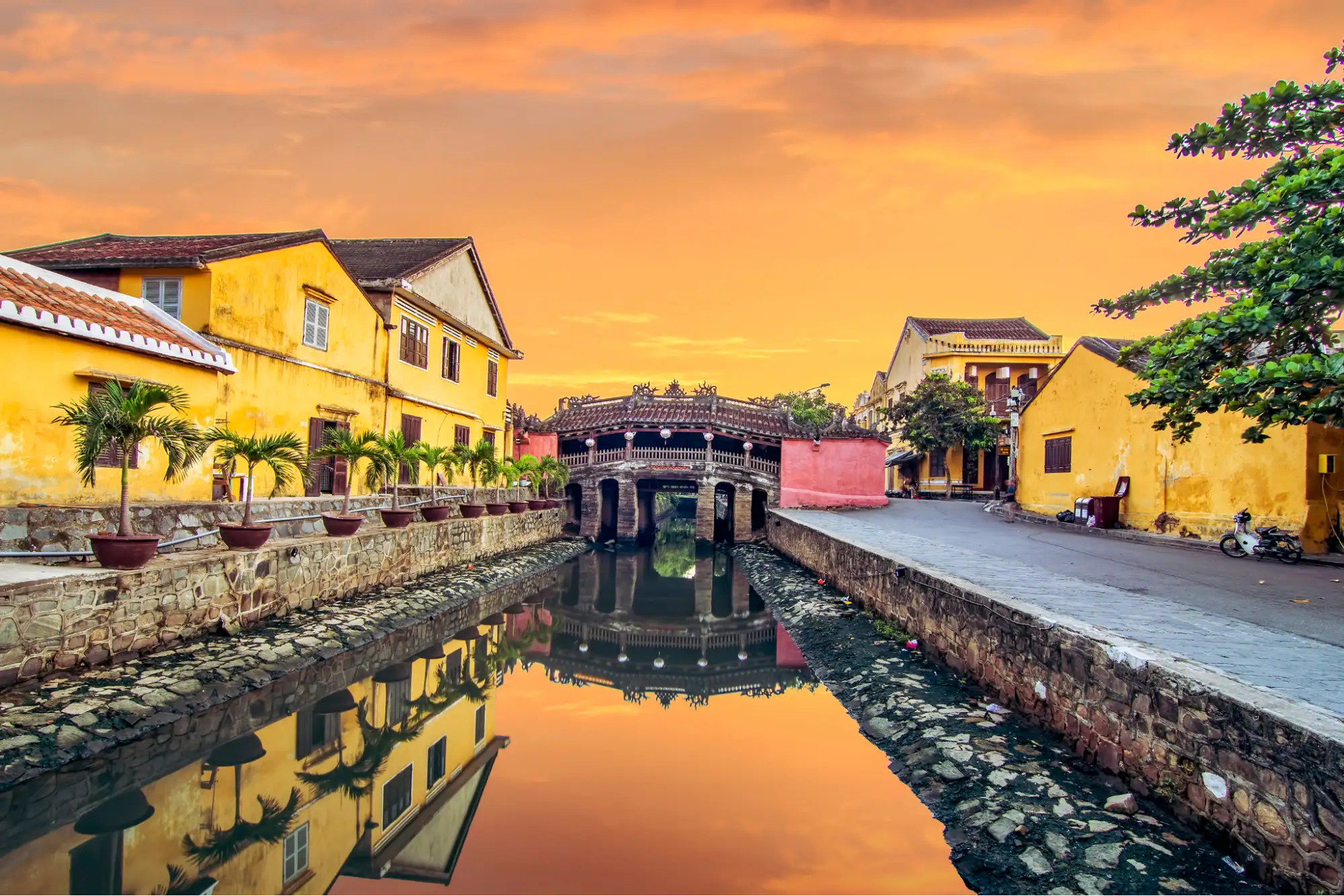
Along the picturesque Hoai River, visitors can enjoy a tranquil atmosphere while also exploring nearby beaches like An Bang and Cua Dai. Hoi An is also famous for its unique local cuisine, including cao lau, mi quang, banh bao, and banh vac, offering an unforgettable culinary experience.
Weather
Hoi An experiences a tropical climate with distinct dry and rainy seasons, each offering unique conditions for travelers.
- Dry season (February-August):
During the dry season, Hoi An enjoys plenty of sunshine, with temperatures ranging from 18-33°C and minimal rainfall. The pleasant weather is perfect for exploring the ancient town on foot, wandering through narrow streets lined with centuries-old houses and admiring the colorful lanterns that light up the evenings. The dry months also provide ideal conditions for visiting nearby craft villages, such as pottery and lantern-making villages, and for spending time at nearby beaches.
- Rainy season (September-December):
The rainy season brings more frequent showers, occasional storms, and the risk of flooding in low-lying areas. Some streets in the old town may become temporarily submerged, affecting walking tours and sightseeing. However, this season also offers a quieter, more relaxed experience with fewer tourists. Travelers can enjoy indoor attractions such as cooking classes, museums, and local markets, or indulge in Hoi An’s renowned culinary scene. While outdoor activities may be limited, the atmosphere of rain-soaked streets and reflective lantern-lit evenings offers a different, romantic charm.
When planning your itinerary, keep in mind that Hue tends to get more rainfall than Hoi An and Da Nang during autumn and winter. A smart tip is to alternate sunny-day outdoor activities (beach time, exploring the Ancient Town) with indoor cultural or culinary experiences to stay flexible despite unpredictable weather.
To keep your trip stress-free, it’s best to prepare a Plan B checklist. In Hoi An, indoor experiences such as cooking classes, spa treatments, or yoga sessions are excellent alternatives. Many tour operators also offer reschedule or postponement policies in case of storms. When booking accommodation, choose a property on higher ground for peace of mind – like Bliss Hoi An Beach Resort & Wellness, where comfort and safety go hand in hand.
Climate highlights by month:
- February-April: cool and comfortable with minimal rain – ideal for walking tours, exploring the old town, visiting craft villages, and enjoying cultural activities.
- May-July: hotter, but still suitable for sightseeing and combining visits with beach activities, water sports, or sunset boat rides on the Hoai River.
- September-November: rainy and stormy, not ideal for outdoor exploration, but perfect for indoor experiences, culinary tours, and less crowded attractions.
Best time to visit
The best time to visit Hoi An is from February to April, when the weather is mild, rainfall is low, and visitors can comfortably explore all the town’s highlights. This is the perfect season to stroll through the lantern-lit streets of the old town, take boat rides along the Hoai River, participate in vibrant lantern festivals, and visit nearby craft villages without worrying about rain disrupting plans.
May – July remains suitable for travelers, especially those looking to combine sightseeing with beach activities. The sun is warmer, making it ideal for swimming, sunbathing at An Bang Beach, or joining various water sports. Travelers should take precautions against the heat by wearing sunscreen, hats, and staying hydrated.
Hue – The serene Imperial city by the Perfume river
Hue, located about 100 km north of Da Nang, was the former capital of the Nguyen Dynasty and is renowned for its rich cultural heritage and historical significance. The city preserves numerous historical sites, royal palaces, tombs, and famous pagodas, all reflecting traditional Vietnamese architecture and artistry.
The winding Perfume River adds a poetic charm to Hue, providing the perfect setting for relaxing river cruises. Notable attractions include the Imperial Citadel (Dai Noi Hue), the Tombs of Tu Duc and Khai Dinh, Thien Mu Pagoda, and many other temples and shrines.

Hue is also famous for its refined cuisine, including Bun Bo Hue, Com Hen, Nem Lui, and Hue-style desserts, offering a flavorful insight into Central Vietnam’s culinary heritage. The city attracts visitors with traditional festivals, royal music performances, and rich cultural activities throughout the year.
Weather
Hue has a tropical monsoon climate with two distinct seasons, each offering different experiences for travelers.
- Dry season (February-July):
The dry season is sunny and dry, with temperatures ranging from 25-34°C. The pleasant weather is ideal for outdoor activities, such as exploring the Imperial Citadel, visiting royal tombs, or taking boat trips along the Perfume River. February to April is generally cooler, making it perfect for walking tours of the ancient streets and historical sites.
- Rainy season (August-January):
This season brings heavy rainfall, occasional storms, and possible flooding, especially from August to November, with average temperatures of 24-30°C. While rain may disrupt outdoor sightseeing, it also creates a refreshing, lush environment and fewer crowds, ideal for culinary experiences, shopping indoors, or participating in cultural classes.
Climate highlights by month:
- February-April: cool and dry, perfect for sightseeing, walking tours, and joining festivals.
- May-July: hotter, still suitable for sightseeing and combining visits with river activities.
- September-November: rainy and stormy, not ideal for outdoor activities; indoor options are recommended.
Best time to visit
If you want to experience Hue at its most comfortable, plan your trip between February and April. During these months, the city enjoys mild temperatures, minimal rain, and plenty of sunshine, making it ideal for wandering through the Imperial Citadel, strolling along the Perfume River, or admiring the intricate details of royal tombs without the hassle of crowds or muddy streets.
For travelers who don’t mind warmer weather, May to July can also be enjoyable, especially if you’re combining sightseeing with a scenic river cruise or visiting nearby beaches. The heat is more intense, but early mornings and late afternoons are perfect for photography and relaxed exploration.
Best time to visit Danang Hoi An and Hue
The central coast of Vietnam offers distinct seasonal charms, and each time of year can bring a different flavor to your journey through Danang, Hoi An, and Hue. Knowing what to expect during each season will help you plan a trip that matches your interests.
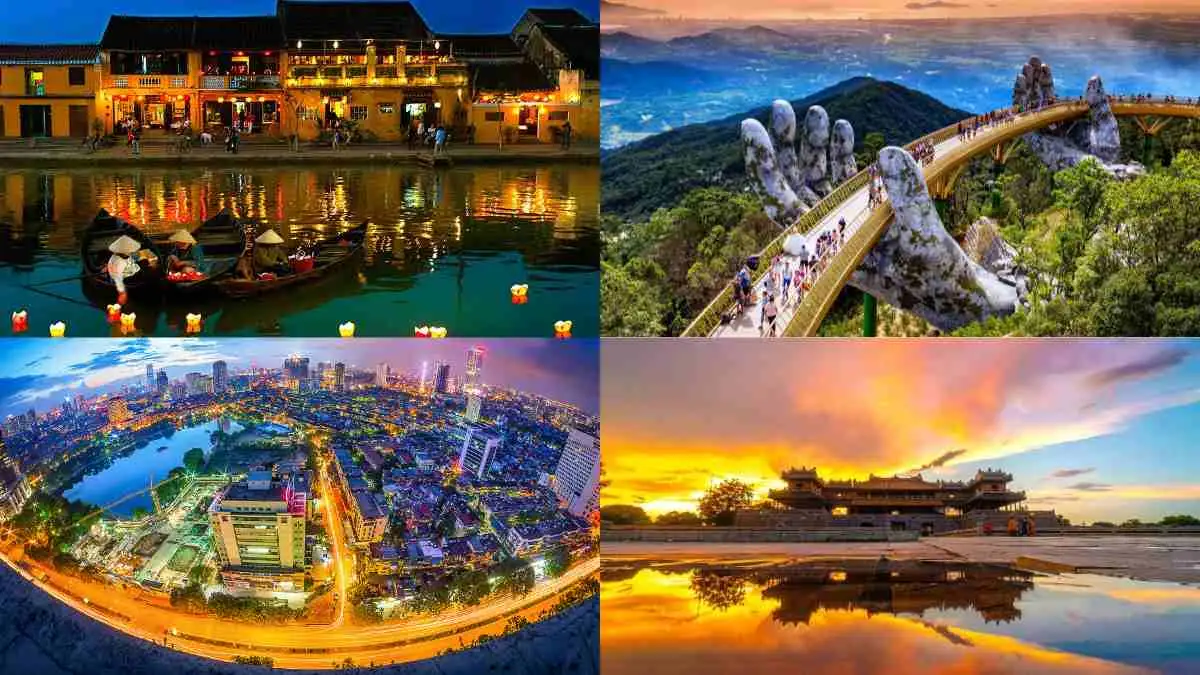
From late winter to early summer (February – May), central Vietnam enjoys its most pleasant climate. The skies are usually clear, humidity is moderate, and the landscapes are at their most inviting. This is the season when the Perfume River in Hue looks especially serene, Hoi An’s old town radiates with glowing lanterns during evening strolls, and Danang’s mountain viewpoints provide sweeping visibility across the coast. Spring also coincides with cultural festivities such as traditional temple fairs in Hue, adding more depth to your visit.
Summer months (June – August) mark the beach season, when Danang’s coastline becomes the highlight. This is when locals and travelers alike gather for late-afternoon swims, seafood feasts, and vibrant night markets. Hoi An’s riverside cafés take on a lively vibe, while boat rides on the Thu Bon River provide a refreshing escape from the heat. Despite the higher temperatures, early mornings and evenings are delightful for exploring the Imperial Citadel in Hue or cycling through quiet countryside lanes near Hoi An.
One of the best ways to decide on your travel dates is by checking seasonal events. In Hoi An, Lunar Lantern Nights on full moon evenings transform the town into a glowing wonderland. Da Nang often hosts outdoor concerts and winter festivals, while Hue celebrates its heritage with food festivals and cultural events. Make sure to check the yearly calendar so you don’t miss out on these highlights.
No matter when you decide to travel, Danang, Hoi An, and Hue each offer unique experiences that reflect the rhythm of central Vietnam’s seasons. If your priority is perfect weather and a balance of culture and nature, spring is hard to beat. For those who thrive on lively beaches and bustling nights, summer brings the coast to life. And if you prefer quiet streets, moody landscapes, and a slower pace, autumn and winter provide a more intimate encounter with these historic cities. The best time truly depends on the kind of journey you are seeking.
After deciding on the best time to visit Danang, Hoi An, and Hue, the next step is to secure your stay. Choosing your accommodation in advance not only gives you peace of mind but also ensures you find the perfect place that matches your travel style, whether it’s a beachfront retreat, a boutique hotel in the ancient town, or a riverside hideaway. Planning ahead makes your journey even more seamless and enjoyable.
Nestled by a tranquil stretch of coastline, Bliss Hoi An Beach Resort & Wellness offers not only comfortable rooms and stunning ocean views but also wellness services and bicycles for guests to discover Hoi An at their own pace. Secure your stay in advance and let Bliss Hoi An be the highlight of your journey.
Read more: Best time to visit Central Vietnam: A complete seasonal guide
Seasonal travel tips for Danang, Hoi An, and Hue
Traveling across Central Vietnam means you’ll experience different microclimates between Danang, Hoi An, and Hue. To make your trip smoother, here are some practical tips based on the weather:
- Pack light and breathable clothes for summer (April-August): Temperatures often rise above 35°C, especially in Danang and Hoi An. Cotton and linen fabrics, hats, and sunglasses are must-haves.
- Bring rain gear in autumn (September-November): Hue and Hoi An face frequent rains and occasional flooding. A compact raincoat or waterproof shoes will save you from unexpected downpours.
- Protect yourself from the sun year-round: Even in cloudy weather, UV levels are high. Sunscreen is essential whether you’re on My Khe Beach in Danang or cycling around Hoi An’s rice paddies.
- Hydrate often: Hot and humid conditions can dehydrate quickly. Carry a refillable water bottle and take breaks in shaded cafés.
- Footwear matters: Choose sturdy sandals or waterproof shoes since you’ll walk through sandy beaches, cobblestone streets in Hoi An, and possibly muddy paths in Hue after rain.
- Timing activities wisely: Start early in the morning or go out late in the afternoon to avoid the midday heat, especially for outdoor sites like Marble Mountains or Imperial City Hue.
Choosing the best time to visit Danang Hoi An and Hue ensures that your journey is not only comfortable but also deeply memorable. Whether you’re chasing the golden beaches of Danang, the enchanting charm of Hoi An, or the historical elegance of Hue, the right season can make all the difference. Take note of the seasonal highlights, prepare accordingly, and let Central Vietnam reveal its beauty in the most magical way possible.






